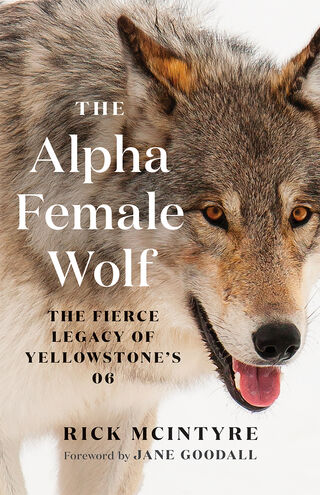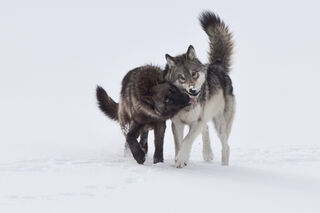Leadership
The Power and Legacy of Yellowstone's Alpha Female Wolf 06
Rick McIntyre's fourth book in a series about wild wolves is an eye-opener.
Posted November 8, 2022 Reviewed by Ekua Hagan
Key points
- "The Alpha Female Wolf" is one of the most important books written about the social behavior of these magnificent carnivores.
- The influence of female wolves, like the females of many other species, clearly shows that males aren't the most important or only show in town.
- In military terms, the alpha female would be the "commanding officer" while the alpha male would be the "executive officer."

Rick McIntyre, who has logged more than 100,000 sightings of Yellowstone's wolves, is a legend―or most people would say the legend―among wolf researchers. Jane Goodall calls him "the ultimate guru of wolf behavior."
Rick's previous three award-winning books covering various and wide-ranging details about the behavior of Yellowstone's wolves are classics.1 His fourth book, The Alpha Female Wolf: The Fierce Legacy of Yellowstone's 06, is another gem. Here Rick highlights the important and influential role that females play in leading packs of wolves, a topic that far too often has been overlooked as many wolf (and other) researchers have narrowly focused on the importance of males.
Here's what Rick had to say about this most fascinating research.
Marc Bekoff: What is a normal day for you?
Rick McIntyre: I have a small cabin a mile from an entrance to Yellowstone National Park. I get up way before sunrise, around 3:15 a.m. on the longer days of the year, so I can be in place to look for wolves by the time there is enough light to see. That is about a half hour prior to sunrise. I find wolves nearly every day, then study their behavior through a high-power spotting scope. I have done that for well over 9,000 days in Yellowstone and now have over 12,000 pages of single-spaced field notes. My books are based on those field observations.
MB: Why did you write this book?
RM: I have been studying wild wolves in Alaska and in Yellowstone for over 40 years and found that packs are led by alpha females. That contradicted the common assumption that the biggest and strongest male rules a wolf pack. To put it more simply: The alpha male just works for the pack leader. In military terms, the alpha female would be the commanding officer while the alpha male would be the executive officer.
I think the primary reason behind that social order is that female wolves plan for the future far more than males. By that, I mean an alpha female makes the most crucial decisions of the year for her family such as where to have her pups. If a den site is placed where hunting will be good, there will be a high pup survival rate. A poor choice could result in the loss of the entire litter.
Another issue is how big male wolves accept being led by a female. I think that goes back to their days as a pup. Mother wolves are very quick and decisive in dealing with pups that wander away from the den. They run over, grab a pup in their mouth, and put it back into the den. I think that is likely the first lesson a young wolf learns: The mother is the boss of the pack.
MB: What would be an example of a successful alpha female?
RM: The main character in The Alpha Female Wolf was known as the 06 Female. Her name refers to her birth year: 2006. She was a strong, intelligent, competent wolf who could kill large prey animals such as elk by herself. Although 06 was courted by many male wolves, she waited until she was middle-aged to settle down. She picked two brothers who were half her age to help start her pack. At the time, her choice did not seem to make much sense due to their inexperience.

06 raised three litters of pups during her lifetime and all those pups survived to adulthood, an impressive record. She was fiercely protective of her pups. When she had her first litter, I saw 06 spend hours dealing with a mother grizzly and her two yearling cubs who were threatening her pups. The mother wolf repeatedly snuck up behind the female bear and bit her on the rear end. The grizzlies would turn and chase the wolf but never could catch her. I saw that each time 06 did that she was luring the bear family further and further away from her pups. She did that 52 times until she was satisfied that the threat was over.
06 had an enemy: an alpha female from a large rival pack who was bigger and stronger than her and who had killed many other wolves. One denning season, that female led her pack of 17 wolves to 06’s den with the likely intent of killing 06 and all her pups. 06 had just given birth and had not yet fully recovered. That meant she had to rely on the two young males she had chosen to protect her and a litter of newborn pups. It would not be fair to my readers to give away what happened that day, but I can say we saw that 06 picked the right guys.
MB: Who is your intended audience?
RM: I write for regular people because wolves need all the supporters they can get in today’s world.
MB: How does your book differ from other books on wolves?
RM: All my books are based on my years of watching Yellowstone wolves generation after generation and all the stories are true.
MB: Do you have any last thoughts on wolves?
RM: I have learned that wolves and humans are very similar in social behavior, probably more so than any other two species on earth. The proof of that is how well the domesticated version of the wolf, the pet dog, fits into a human family.
Wolves and people both live and function primarily in small groups. For us, that would be families and work groups. Individual humans and wolves have to cooperate with others in their group to be successful. But to some degree, humans and wolves also are competitive with each other in our respective groups.
Balancing those two opposing issues is challenging for us just as it is for wild wolves. After decades of watching wolf packs, I would say that wolves who are good at cooperating with pack mates tend to be more successful than ones that are overly aggressive to others in the group.
References
In conversation with Rick McIntyre. Rick has spent more time observing and documenting wolves in the wild than any other person. A retired National Park ranger, he has spent more than forty years watching wolves in America’s national parks, twenty-five of those years in Yellowstone, where he has accumulated over 100,000 wolf sightings, worked on the Yellowstone Wolf Reintroduction Project, and educated the public about the park’s wolves.
1) See also: The Story of Yellowstone Wolf 8: From Underdog to Alpha Male, The Reign of Wolf 21, Yellowstone's Benevolent Alpha Male, and The Redemption of Yellowstone's Renegade Alpha Wolf 302. For more on the importance of females in different animal societies see "Bitch" Repositions Female Animals to Where They Belong.




